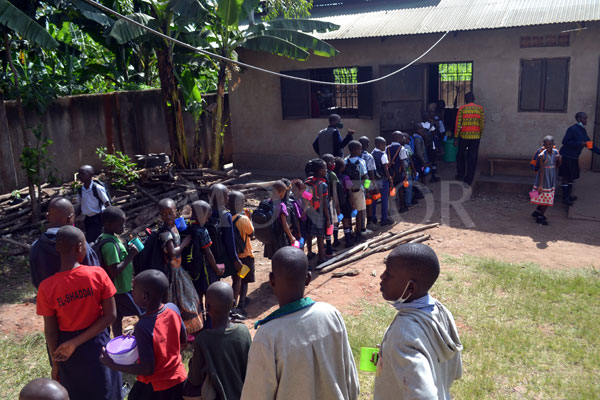Prime
How schools are coping two years after closure

Pupils of Njeru Primary School in Jinja District queue for breakfast at the school on Thursday. The school management says they have avoided admitting new pupils due to lack of space to guarantee some of the anti-Covid measures such as social distancing requirement. PHOTO/DENIS EDEMA
What you need to know:
- It is now a week since schools reopened. Shabibah Nakirigya & Denis Edema find out how some of them are dealing with challenges, such as low learner turnout and shortage of teachers.
It is now one week since the schools reopened countrywide after the nearly two years’ lockdown caused by the Covid-19 pandemic.
Despite the surge in Covid-19 cases spurred by the Omicron variant, the government fulfilled its promise to reopen schools on January 10.
However, schools have experienced several challenges, including low turnout of students, shortage of teachers and lack of funds to renovate the facilities.
Mr Robert Lwanga, the deputy chairperson of private schools in Wakiso District, who also doubles as the head teacher of Lukwanga Secondary School in Wakiso District, says the shortage of teachers has mostly affected primary schools where some teachers opted to join other businesses.
“In the survey we have done for the first week in Wakiso District, we have realised that in secondary schools, the teachers are there but the learner turnout is still very low because many have dropped out of school after spending two years at home,” he says.
Mr Constantine David Kawuma, the head teacher of St Mathias Kalemba –Nazigo in Kayunga District, says in the first week of resuming studies, they have been able to hold beginning of term meetings with the teachers to assess their status in regard to being ready to resume work.
“I am happy to note that the turnout for teachers is at 100 percent. We are basically working up the teamwork level and improve staff enthusiasm so as to ensure they receive and attend to the learners,” he says.
Mr Kawuma adds that teachers must have extra time to attend to the learners because they have spent two years at home, with many fears, challenges and expectations.
Mr Kawuma says they are working under the guidance of the Ministry of Education and Sports in regard to automatic promotion of learners to the next classes.
“We had to sit as departments and we are coming up with strategies to make sure the teachers cover what is expected of them because we have a load of two years’ content to be covered in one year,” he says.
Asked about how the school managed to get back all the teachers they had before the lockdown, Mr Kawuma says the school administration kept on checking on the teachers and visiting some during the lockdown, and where possible, giving a hand in case they needed help.
“We have about 60 teachers and they are staying in different parts of the country, but we managed to check on them through phone calls to make sure they were okay,” he says.
Mr Eddie Kayinda, the director of Children’s Foundation Uganda in Lwengo District, says the schools have had significant challenges during the reopening, especially those in hard-to-reach areas where many teachers failed to return to class.
“We had more than 15 teachers but only seven returned and we are now recruiting new teachers to fill the gap. Most of them declined to return to teaching, citing the little money they were earning, especially in the private sector,” he said.
Mr Kayinda adds that others have opted to join other businesses.
He also reveals they are having challenges with the learners’ changed social behaviours. He says some learners have returned with very anti-social behaviours due to the long period they have stayed away from the school environment.
“We are finding it very difficult and challenging to settle these children in the learning environment and direct them in the teaching and learning processes. We have opted to engage these children in counselling sessions but some of them will still tell the counsellor to rush the session because they have other things to manage at home,” he says.
Mr Kayinda adds that some learners say they had started some businesses and the schools should not stop them from carrying on with them.
Many learners now sell face masks in the communities around them, others resorted to making bricks or attending to market stalls.
“The number of learners that have returned to schools in hard-to-reach areas has significantly dropped. In the first week, we had only about 40 percent of the enrolment we had before the lockdown. But we doubt we shall have more than 60 percent of the learners back because of several factors, including failure by some parents to get money to pay schools fees and other requirements,” he says.
Mr Moses Kamwami, the director of studies at Canaan CTC Nursery and Primary School Njeru in Jinja District, says new pupils, especially those in lower primary, are finding it difficult to cope with the new content after they were automatically promoted to the next classes.
“Some of them have returned looking physically too big to be in the classes that they are returning,” he says.
Mr Farouk Musuuba, the head teacher of Njeru Primary School in Njeru Municipality, Jinja District, says he avoided admitting new pupils due to lack of space to guarantee some of the anti-Covid measures such as social distancing requirement.
Mr Peter Ssekyanzi, the director of studies at St Noa Mawaggali SS Mbiko in Jinja, says they had to subject some learners, especially those from other schools, to interviews before they could promote them to the next classes.
“When you ask the parents for the previous class report card, they claim it was not picked or it got lost, so in such a situation, we have to access them before joining class,” he says.



